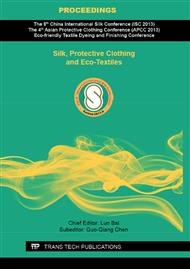[1]
D.H. Reneker, A.L. Yarin, H. Fong and S. Koombhongse, Bending instability of electrically charged liquid jets of polymer solutions in electrospinning, Journal of Applied Physics. 87 (2000) 4531-4547.
DOI: 10.1063/1.373532
Google Scholar
[2]
F.L. Zhou, R.H. Gong and I. Porat, Three-jet electrospinning using a flat spinneret, Journal of Material Science. 44 (2009) 5501-5508.
DOI: 10.1007/s10853-009-3768-1
Google Scholar
[3]
S. Petrík, Industrial production technology for nanofibers, in: T. Lin (Eds. ), Nanofibers - Production, Properties and Functional Applications, InTech, Rijeka, 2011, pp.3-16.
Google Scholar
[4]
A. Arinstein and E. Zussman, Electrospun polymer nanofibers: mechanical and thermodynamic perspectives, Journal of Polymer Science Party B: Polymer Physics. 49 (2011) 691-707.
DOI: 10.1002/polb.22247
Google Scholar
[5]
W. Tomaszewski and M. Szadkowski, Investigation of electrospinning with the use of a multi-jet electrospinning head, Fibers & Textiles in Eastern Europe. 13 (2005) 22-26.
Google Scholar
[6]
A. Varesano, F. Rombaldoni, G. Mazzuchetti, C. Tonin and R. Comotto, Multi-jet nozzle electrospinning on textile substrates: observations on process and nanofibre mat deposition, Polym Int. 59 (2010) 1606-1615.
DOI: 10.1002/pi.2893
Google Scholar
[7]
T. Lin, Needleless Electrospinning: A practical way to mass production of nanofibers, Journal of Textile Science and Engineering. 2 (2012).
DOI: 10.4172/2165-8064.1000e109
Google Scholar
[8]
R. Dersch, T.Q. Liu, A.K. Schaper, A. Greiner and J.H. Wendorff, Electrospun nanofibers: internal structure and intrinsic orientation, Journal of Polymer Science: Part A: Polymer Chemistry. 41 (2003) 545-553.
DOI: 10.1002/pola.10609
Google Scholar
[9]
H. Yan, L.Q. Liu and Z. Zhang, Continually fabricating staple yarns with aligned electrospun polyacrylonitrile nanofibers, Materials Letters. 65 (2011) 2419–2421.
DOI: 10.1016/j.matlet.2011.04.091
Google Scholar
[10]
F.L. Zhou, R.H. Gong and I. Porat, Mass production of nanofibre assemblies by electrostatic spinning, Polym Int. 58 (2009) 331-342.
DOI: 10.1002/pi.2521
Google Scholar
[11]
H. Pan and L. Li, Continuous aligned polymer fibers produced by a modified electrospinning method, Polymer. 47 (2006) 4901-4904.
DOI: 10.1016/j.polymer.2006.05.012
Google Scholar
[12]
Information on http: /dspace. library. drexel. edu/handle/1860/282.
Google Scholar
[13]
H.Y. Kim, WO No. 073442. (2005).
Google Scholar
[14]
E. Smit, U. Buttner and R.D. Sanderson, Continuous yarns from electrospun fibers, Polymer. 46 (2005) 2419-2423.
DOI: 10.1016/j.polymer.2005.02.002
Google Scholar
[15]
W.E. Teo, R. Gopal, R. Ramaseshan, K. Fujihara and S. Ramakrishna, A dynamic liquid support system for continuous electrospun yarn fabrication, Polymer. 48 (2007) 3400-3405.
DOI: 10.1016/j.polymer.2007.04.044
Google Scholar
[16]
M.S. Khil, S.R. Bhattarai, H.Y. Kim, S.Z. Kim and K.H. Lee, Novel fabricated matrix via electrospinning for tissue engineering, Journal of Biomedical Materials Research Part B: Applied Biomaterials. 72B (2005) 117–124.
DOI: 10.1002/jbm.b.30122
Google Scholar
[17]
Y. Liu, J. Li and Z.J. Pan, Effect of spinning conditions on the mechanical properties of PA6/MWNTs nanofiber filaments, Journal of Polymer Research. 18 (2011) 2055-(2060).
DOI: 10.1007/s10965-011-9614-6
Google Scholar


